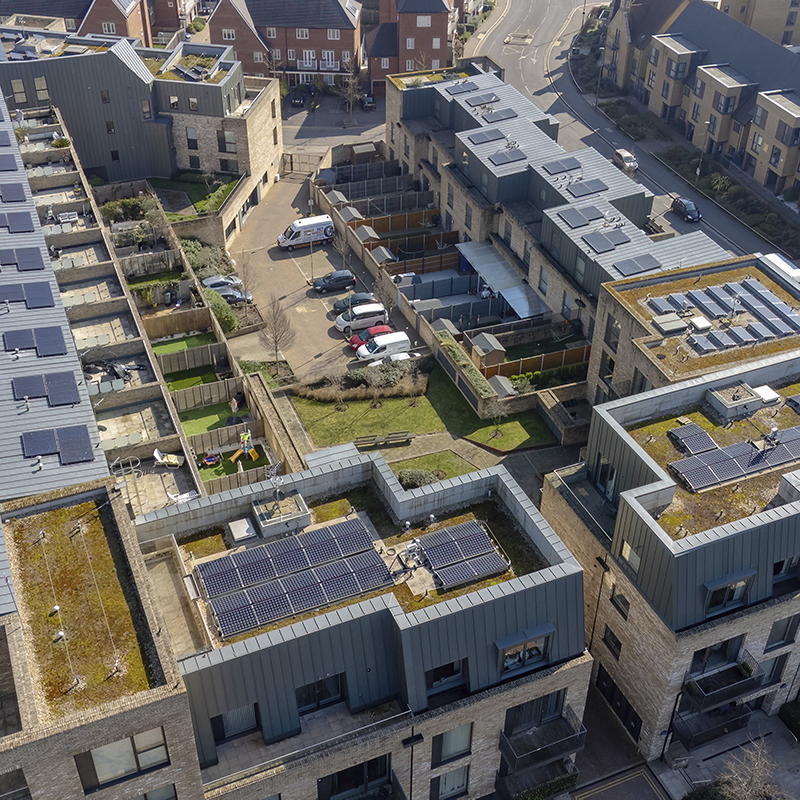Radmat discusses how the ‘fifth façade’ can help mitigate climate change.
In association with![]()
A new report from the University of Southampton’s Energy and Climate Change Division, School of Engineering, commissioned by the NFRC Charitable Trust, highlights some key steps that specifiers, building owners and home owners can take to use the roof to help mitigate the impacts of climate change.
While the largest roofing trade association in the UK could be expected to promote the contribution roofs can make to managing climate change, the award-winning environmental charity Hubbub also recognises the valuable contribution that roofs can make; so much so that one of its 10 ‘Asks’ in The Greenprint is to ‘ensure no roof goes unused.’
As a market leading innovative flat roofing system provider, Radmat Building Products fully endorse the recommendations in the ‘Building resilience of roofing technologies in a changing climate’ report and already have an aligned product range that fully supports specifiers in following this direction of travel and improving the built environment.
‘Building resilience of roofing technologies in a changing climate’ recommendations:
Radmat’s ProTherm Quantum PLUS+ insulation board
Conventional (consolidated technologies)
These are technologies that are consolidated in the market currently in both the residential and non-residential sectors, such as enhanced levels of insulation and improving airtightness. The updates to Approved Document L reflect this, with the new rules coming into force in June 2022* requiring a mandatory 30 per cent cut in carbon for all new homes with a 27 per cent cut for other buildings, plus new minimum efficiency standards being introduced for new and replacement thermal elements (walls and roofs), windows and doors.
A new ‘principal performance metric’ will be introduced, which will increase the demand for solar photovoltaic (PV) systems on roofs bringing both opportunity and risk if third party trades work on the roof.
The improvements in both the notional U-Value of a dwelling roof (from 0.13 W/m²K to 0.11 W/m²K) and the maximum U-Value of a dwelling roof (from 0.20 W/m²K to 0.16 W/m²K) will result in the thickness of the most commonly used insulation boards on projects increasing, along with the cost of the insulation.
Radmat’s range of insulation boards includes the most thermally efficient XPS insulation boards on the market and the Worlds thinnest inverted roof insulation boards, with both ProTherm G XPS X 300 SL and ProTherm Quantum PLUS+ being BBA certified. Never has it been more important to ensure that every roof is designed to optimise thermal efficiency within the design constraints of the roof or terrace.
Photo: Jon Lucas
Cool (highly reflective coatings)
A cool roof is one that is designed to reflect more sunlight and absorb less heat than a conventional roof, typically flat or low sloped. A highly reflective type of paint, sheet covering, tiles or shingles can be used to achieve this.
Radmat’s single ply membranes and liquid applied membranes provide light colour finishes for warm roofs, and our inverted roof systems can be finished with light coloured paving, porcelain tiles or energy capturing green roofs.
Photo: Jon Lucas
Green (vegetated)
These are ballasted roofs that cover a conventional roof (typically flat) with a waterproofing later, growing medium (soil) and vegetation (plants).
Radmat’s MedO extensive, wildflower and biodiverse green roof range provide self-sustaining plant communities that replicate or replace the natural environment that was there before construction; enhancing both flora and fauna in the local environment, as well as helping mitigating pollution, airborne noise, improve health and wellbeing and provide amenity.
Photo: Benedict Luxmoore
Blue (vegetated with enhanced stormwater attenuation capacity)
These are roofs that are designed to slow the drainage of rainwater collected above the waterproof element, unlike conventional roofs which allow rainwater to drain quickly away from the roof.
Radmat’s Blue Roof systems provide roof level attenuation and discharge rate control, meeting the requirements for the London Plan 2021. The installation of the Radmat Blue Roof system at The Forge won the Roofing and Drainage award at the AJ Specification Award 2020 and features in the NLA report ‘Resilient London’ produced for COP26.
Contact Details
To find out more about Radmat’s product range go to www.radmat.com; for design support to help mitigate climate change email; or call 01858 410372.
Source: Architecture Today








